Don’t overlook pest control as part of GMP regulation of facilities and warehouses
Integration technology and experienced program management keep problems from arising
Given that nearly all pharmaceutical facilities operate under GMP guidelines, and in the most tightly controlled instances have sealed rooms, filtered air and operators walking around in bunny suits, it might be expected that pest control is a minimal priority. However, many of those products in controlled environments move to less-controlled packaging lines, and thence to warehouses. Conditions at pharma customers—the wholesale-distribution network—are also regulated, but these environments of necessity open their doors routinely to take products in or ship them out. Pest control is an active part of operations.
Rentokil Steritech, a leading provider of pest control solutions for commercial properties, has considerable experience in handling these issues. The company combines broad expertise in general pest control—which includes rodent management and flying insect control, termite services, bioremediation, integrated bird management, fumigation, vegetation management services and wildlife management—with technology to monitor and target control solutions.

Most recently, it has introduced the Dual Autogate Connect system is a unique electronic bait station designed to enhance clients’ exterior rodent protection program. Dual Autogate Connect's smart gate mechanism (see figure) can differentiate between target and non-target species and opens when rodent activity is detected. When the sensor is triggered three times based on activity, the motorized door will open allowing the rodents access. Dual Autogate Connect, like other Rentokil Steritech products, connects to PestNetOnline, a networked data management system. It is accessible 24/7 and businesses can receive real-time information, allowing them to identify risks, as well as recommendations and trends across their operations.
According to the company, there are a number of practical measures that life sciences companies can take to keep pest problems to a minimum:
• Have a risk-based integrated pest management program. For all pharmaceutical and related facilities, it is important to have a risk-based integrated pest management program in place, where controls are established in areas of high risk or likely pest entry or access – including rodents, insects, wildlife, and birds. A reputable pest management provider can perform a thorough inspection of a facility and help identify risk points based on an operation's unique geography, environmental conditions, products, and processes.
• Establish a contracted pest management partnership. It's critical for facility to have a good working partnership with a contracted pest-management provider so that its personnel are monitoring those risk points, using the data to modify the program as needed, and identifying potential new risk points. Communication is absolutely critical – facilities should communicate changes to their processes and facility, and pest management providers should provide detailed communications or documentation on the actions that they have taken, activity found, and recommendations for pest prevention.
• Seal cracks and crevices. Small insect pests and rodents can enter your facility through the smallest of cracks and crevices – mice can fit through a space the size of a dime, while rats can enter through an opening slightly larger than the size of a quarter. It is important for facilities to conduct routine inspections of the exterior of buildings to identify and properly seal these potential entry points. Thorough inspections should be conducted a minimum of yearly; however, quarterly or seasonal inspections may help to identify new conditions before a problem occurs. Rentokil Steritech's services include this annual inspection, as well as our Pest Specialists conducting spot inspections and sealing small gaps and cracks during routine services.
• Conduct regular rooftop inspections. Just like the exterior of a facility, paying close attention to rooftops can help you identify potential pest issues before they become a problem. Roof inspections should be conducted a minimum of quarterly. Look for and remove pooling water. Trim back any vegetation that is touching the rooftop, as this may provide a highway for pests to access your structure. If you notice evidence of bird activity, such as feathers or droppings, around HVAC units, call in a pest management professional with bird management experience for help.
• Change lighting. Adjusting exterior lighting may help to drastically reduce flying insect issues. Use sodium vapor bulbs instead of mercury; alternatively, incandescent (low wattage) or LED lights (not high output) can be utilized, but it's a good idea to have a pest management professional advise you on the best options for a facility before making changes.
• Ensure that landscaping doesn't create pest-friendly conditions. Consider landscaping in a pest management overview. There should be an 18-inch vegetation-free perimeter between the building and any landscaping to help reduce the potential for pest harborage. Gravel or egg rock can be utilized to create this perimeter. Be sure that automatic watering systems are not over-watering to keep the areas near the building as dry as possible. If you have a large campus, have landscapers mow outward from the building to the edges of the property to avoid pushing any pests in toward the building.
For additional information on Rentokil Steritech and their full integrated pest management services in the United States, visit www.rentokil-steritech.com.